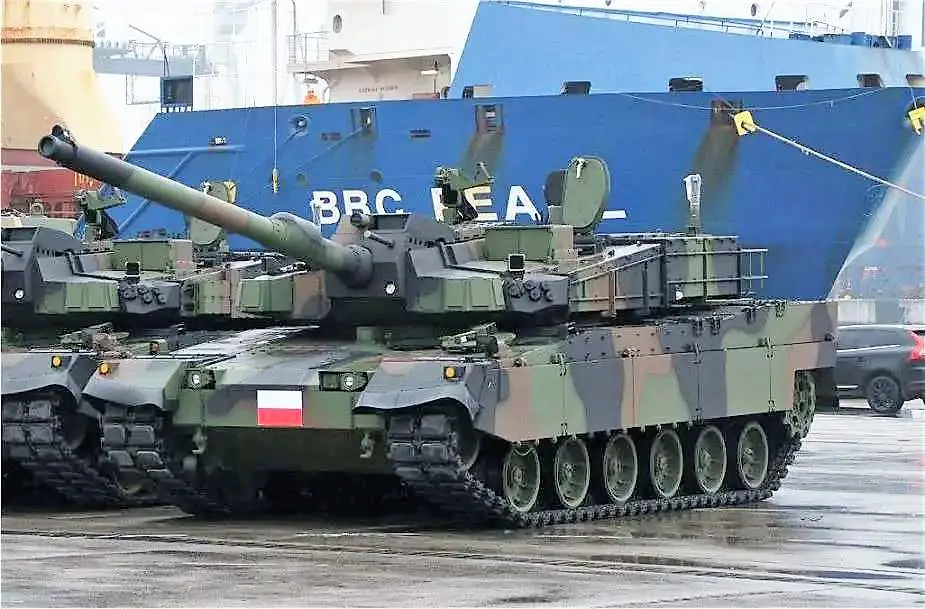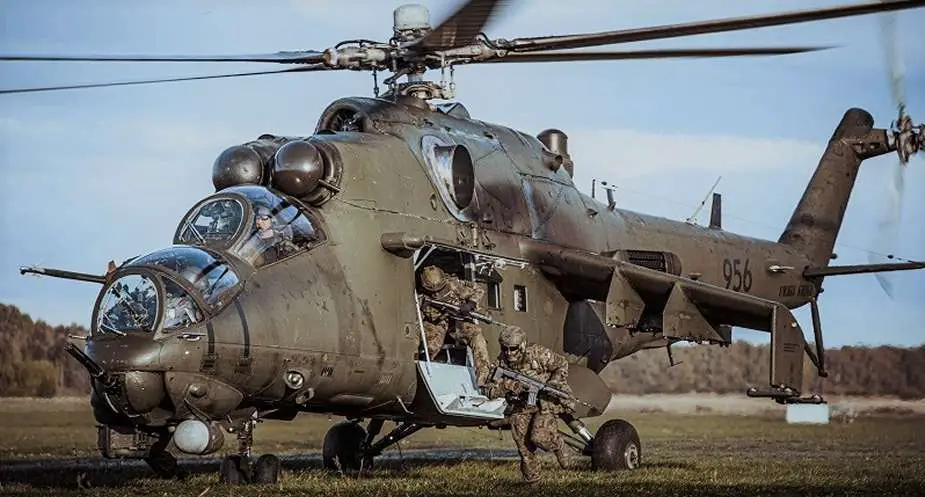As reported in opex360.com by Laurent Lagneau.A large array of vehicles including American M1A2 Abrams and South Korean K2PL Black Panther tanks, South Korean K9 Thunder and Polono-Korean AHS Krab self-propelled howitzers, South Korean K239 Chunmoo and American M142 HIMARS MLRS, have been procured. Complementing these are South Korean FA-50 Golden Eagle light fighters and American F-35A Lightning IIs. The acquisitions extend to include strategic observation satellites, the American AH-64E Guardian/Apache attack helicopters, as well as potent air defense systems and even submarines.
Follow Army Recognition on Google News at this link

New South-Korean made K2PL Black Panther Main Battle Tanks delivered to the Polish Army (Picture source: Polish Mod)
The acquisitions pursued by Poland serve multiple strategic objectives. They go beyond mere equipment replacement for Ukraine, intending to bolster the country's military readiness. The augmentation also aligns with a broader ambition to counter the escalating Russian influence, thus effectually fortifying its armed forces. A noteworthiness of these endeavors is Poland's unambiguous goal to establish itself as the preeminent conventional force in Western Europe. This very aspiration reverberated in the statements attributed to Sergei Shoigu, Russia's Defense Minister, on the 9th of August.
As anticipation built ahead of a meeting with senior Russian military officials, Shoigu articulated the amplification of security challenges originating from western and northwestern directions over the recent years. A resolute response, Shoigu asserted, was obligatory in the face of these so-called menaces. He delineated a discourse centered around neutralizing these emergent challenges.
Foremost among these concerns is the unprecedented support extended by NATO member states to Ukraine. According to Shoigu, this concerted investment by Western powers into Ukrainian military capabilities, aimed at tilting the balance on the battlefield, entails the risk of exacerbating the ongoing conflict. His views resound closely with the overarching narrative emanating from the Kremlin.
Shoigu further cast the spotlight on the accession of Finland and Sweden into NATO. This development, precisely a consequence of Russia's actions in Ukraine, was deemed by him as a significant destabilizing factor. The lengthening of the shared border between Russia and the NATO-covered territories has, in Shoigu's estimation, imparted an added layer of tension. This, as observers have noted, presents an ironic outcome of Russia's own actions.
Adding to these apprehensions is what Shoigu dubbed the "militarization" of Poland. He posited Poland as a principal instrument in the United States' anti-Russian strategy. The ambitious endeavor by Poland to erect an imposing conventional military force is seen through this lens. This aspiration has driven Poland's acquisition of substantial weaponry from the United States, Great Britain, and South Korea. Shoigu emphasized the risk this poses to Russia. A pertinent note from the Polish defense-focused site, Defence24, is that Shoigu sidesteps acknowledging the causal link between Russia's aggressive policies and Poland's bolstered military posture.
Polish Defense Minister Mariusz Blaszczak announced a surge in troop deployments to the Belarus border, aimed at bolstering the Border Guard's capabilities. Blaszczak elaborated that approximately 10,000 troops would be stationed in the vicinity, with 4,000 directly supporting the Border Guard and the remaining 6,000 held in reserve. The strategic rationale behind this maneuver is to forestall any aggression, including plausible provocations.
Poland has grown increasingly concerned about the border area since hundreds of battle-hardened Wagner mercenaries arrived in Belarus last month upon the invitation of President Alexander Lukashenko for "training purposes." A Polish general has cautioned that Poland has positioned attack helicopters near the Belarus border and their crews will not hesitate to employ weapons if necessary. The Polish Defense Minister has also stressed "the need to expand [Poland's] military presence" on the Belarus border. Polish Defense Minister Mariusz Blaszczak has forecasted that provocative actions could be anticipated to escalate.
Nevertheless, some Polish initiatives may appear counterproductive, Laurent Lagneau writes, as they could reinforce the Kremlin's narrative. An example of this is the decision to officially revert the Polish name "Krolewiec" to the Russian enclave of Kaliningrad (called "Königsberg" from the Prussian era until the end of the Third Reich and its annexation by Russia). In June 2023, Waldemar Buda, the Polish Minister of Development, justified this move: "The act of giving the name Kalinine to a large city near our border, a criminal co-responsible for the mass execution of Polish officers in Katyn in 1940, evokes negative emotions in Poland." The Katyn massacre was a series of mass executions of nearly 22,000 Polish military officers and intelligentsia prisoners of war carried out by the Soviet Union, specifically the NKVD ("People's Commissariat for Internal Affairs", the Soviet secret police, the precursor of the KGB) in April and May 1940. Though the killings also occurred in the Kalinin and Kharkiv prisons and elsewhere, the massacre is named after the Katyn forest, where some of the mass graves were first discovered by German forces. The order to execute captive members of the Polish officer corps was secretly issued by the Soviet Politburo led by Joseph Stalin.

Polish Army Mil Mi-24 Hind attack helicopter. A Polish general has cautioned that Poland has positioned attack helicopters near the Belarus border and their crews will not hesitate to employ weapons if necessary (Picture source: Polish Armed Forces/Wojsko Polskie)
Defense News August 2023















